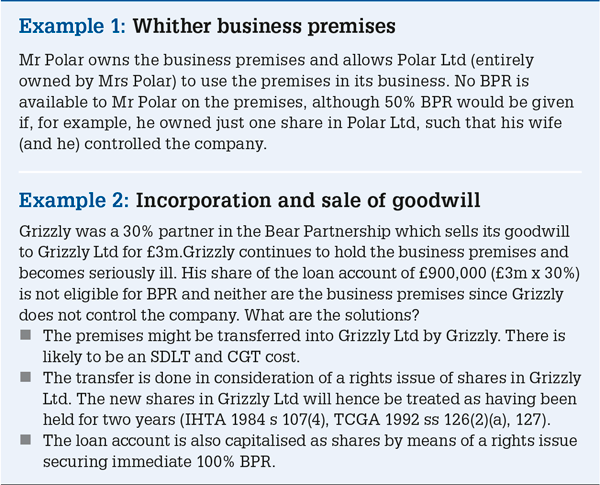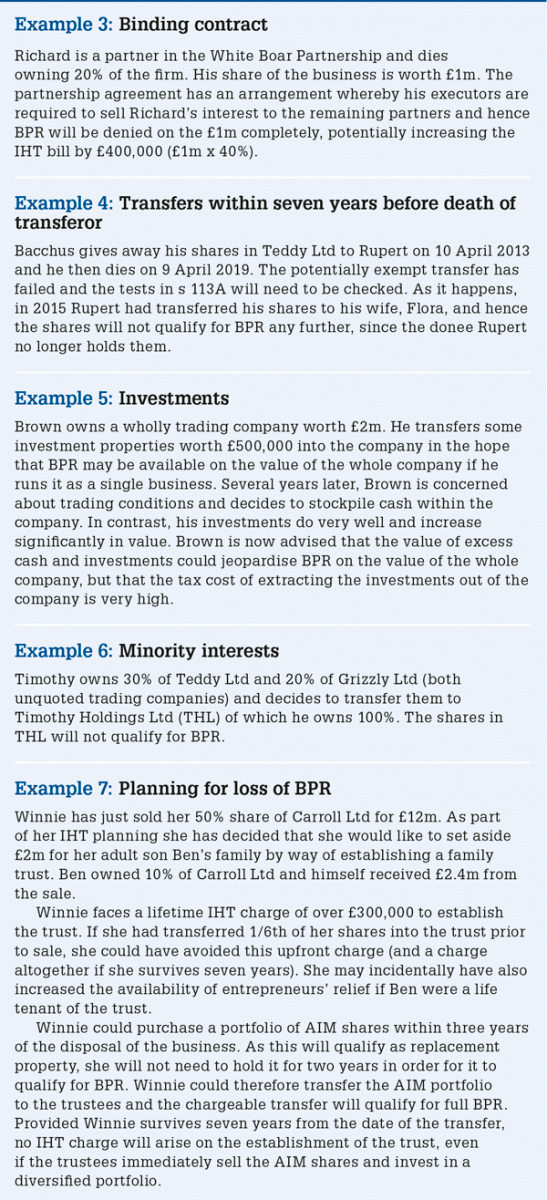A claim for business property relief may be a once in a lifetime occasion, but vigilance is required to ensure that it is a happy one. ‘Bear traps’ can arise inadvertently in straightforward commercial situations, namely where: the premises are owned by one spouse, while the other spouse owns the company; a business is incorporated and the goodwill sold to a new captive limited company; there is a binding contract for sale of the asset in question; transfers are made within seven years before the death of the transferor; the investment element of a business is predominant; and holders of a number of minority interests in an unquoted trading company are grouped together under a holding company.
A claim for business property relief may be a once in a lifetime occasion, but vigilance is required to ensure that it is a happy one.
 Advisers should be aware of the following potential ‘bear traps’ concerning business property relief.
Advisers should be aware of the following potential ‘bear traps’ concerning business property relief.
 A key factor will be whether to hold this valuable asset inside the (potentially risky) trading partnership or limited company concerned. This will certainly give simplicity and in normal circumstances the value of the property will effectively qualify for 100% business property relief (BPR). Outside the business, BPR of no more than 50% will be available and this will only be if the landlord is a partner in the partnership concerned or if he controls the limited company in question (IHTA 1984 s 105(1)(d)).
A key factor will be whether to hold this valuable asset inside the (potentially risky) trading partnership or limited company concerned. This will certainly give simplicity and in normal circumstances the value of the property will effectively qualify for 100% business property relief (BPR). Outside the business, BPR of no more than 50% will be available and this will only be if the landlord is a partner in the partnership concerned or if he controls the limited company in question (IHTA 1984 s 105(1)(d)).
It should be noted that this relief will only apply to land, buildings, machinery or plant and will not extend at all to goodwill, other intangibles or intellectual property rights, for which no BPR will be given if held outside the business.
A bear trap exists where perhaps the premises are owned by one spouse and it is the other spouse who owns the company in question. Perhaps the shares will have been transferred inter-spouse to minimise income tax on dividends, with ill advised consequences. See example 1 below.
It should be noted that there is no need for a formal lease or binding arrangement between the landlord and the trading business. It is merely sufficient for the property to be used in the business. There is no requirement for a rent to be charged.

Unforeseen reductions in BPR can inadvertently arise if a business incorporates with a view to offering greater commercial protection, as well as reduced tax on profits.
A common strategy is for the sole trader or partners to sell the goodwill of the business on loan account to a new captive limited company and for this then to operate the trade. Although potentially highly tax effective, it may bring unintentional IHT bear traps in that:
the loan account created by the sale of goodwill will not qualify for BPR; and
the landlord now needs to control the company to obtain 50% BPR, rather than merely being an owner as in the partnership scenario.
See example 2 above.
IHTA 1984 s 113 will deny BPR completely where there is a ‘binding contract for sale’ of the asset in question – the principle being that what is being gifted is not a business asset but a right to the sale proceeds thereof. Practitioners should review partnership and shareholder agreements to ensure that there is no such automatic ‘buy and sell’ arrangement in the event of, for example, death or leaving employment. In practice, most agreements of this type are carefully drafted so that a ‘double option’ arrangement exists – the transferor (or his representatives) has an option to sell and the potential purchaser has an option to buy. This should prevent s 113 applying. Occasionally, in the writers’ experience, one comes across unfortunately drafted agreements with unintended consequences. See example 3.

Clients may look to benefit the next generation through gifts of assets qualifying for BPR, and in one or two cases recently, the authors have seen these accelerated due to fears that the statutory relief for BPR may be curtailed. Where BPR assets are given away by means of a potentially exempt transfer, it is key that the conditions in IHTA 1984 s 113A are satisfied at the time of death if this is within seven years of the transfer. It is important, for example, that the transferee still owns the shares and they still constitute ‘business property’.
One bear trap is where the BPR asset in question is subsequently sold and hence the transferee owns cash at the date the transferor dies. If the transferor in such circumstances became terminally ill, the transferee might look to buy further assets qualifying for BPR, with a view to taking advantage of the replacement asset provisions (IHTA 1984 s 113B). This can be done before or after the death of the transferor, provided that the new asset is acquired within the permitted period.
Another aspect is that not only do the assets need to qualify for BPR at the date of the transferor’s death, but the transferee needs to hold the asset. A potential bear trap exists if, for example, the shares have been transferred by the transferee to their spouse, with a view to mitigating income tax on dividends. See example 4 above.
Practitioners will be aware that businesses consisting wholly or mainly of making or holding investments will not qualify for BPR (IHTA 1984 s 105(3)). Further, even if a business qualifies for BPR because it is mainly carrying on a qualifying activity, the value of any assets will be excluded from relief if: they have not been used for the purposes of the business throughout the previous two years; or they are not required for the future use in the business at the time of the transfer.
The important point to consider here is that, if the investment element of a business is predominant, no BPR will be available at all. We also need to consider what the ‘business’ is. If there is a single business, which may include some element of investment activity, BPR will not be restricted unless this is the main activity. If two separate businesses are being conducted, one of which is the making or holding of investments, the value of assets used for the investment business will be excluded from relief. Business owners may have been encouraged by recent cases such as Brander (Personal Representatives of the late 4th Earl of Balfour) v HMRC [2010] STC 2666, to transfer ‘investment’ assets into their business in the hope that BPR will available on all assets, on the basis that a single business is being operated.
It should be remembered however that the cases in this area, which appear to have been generous to the taxpayer, have been decided on very specific circumstances and have generally centred on land-based activities, such as farming or mixed estates. It is likely to be far more difficult to demonstrate that, say, an engineering business holding investment properties is being run as a single business.
Even if the business owner is confident that the trading and investment elements can be run as a single business, there is a bear trap if the trading element decreases while investments rise in value. See example 5 above.
We also need to consider what constitutes an ‘investment activity’. In the recent case of Pawson (HMRC v Lockyer & Robertson (Pawson’s Personal Representatives) [2013] UKUT 50 (TCC)), it was found that it is the nature of the activity that is engaged in that is important, not the level or degree of activity. In this case, it was found that the activity of finding customers for a holiday rental property was the same in nature as sourcing any tenant for a property activity, i.e. an investment activity, despite the much higher levels of activity required for a property let on a weekly basis.
Land-based businesses may continue to be vulnerable to falling on the wrong side of the ‘investment’ line and a regular review of the activities undertaken and the services offered by the business should be undertaken.
Finally, corporate group situations also need to be considered. It should be remembered that investments in minority holdings or 50:50 joint ventures will be investments, whereas the value of qualifying subsidiaries may qualify for BPR if the holding company is wholly or mainly a holding company of qualifying subsidiaries (IHTA 1984 s 105(4)(b)). If the holding company is also trading in its own right, the value of the subsidiary may be treated as an investment if the trading activity of the parent is predominant as it will not be ‘wholly or mainly a holding company of trading subsidiaries’.
BPR should be available on shares in any unquoted trading company and there is no de minimis for the level of shareholding, unlike say for capital gains entrepreneurs’ relief. However, holders of a number of minority interests must avoid the temptation to group them together under a holding company since, although this may give other tax benefits, the shares in the holding company will constitute ‘investments’ and therefore be barred from BPR by IHTA 1984 s 105(3). The writers have seen this done quite often and it does seem to be a bear trap to avoid. See example 6 above.
There will be times when business owners have to face the consequences of losing BPR. The most common scenario is when the time has come to sell the business. Many business owners may not consider how they wish to use their proceeds until after the sale has been completed.
It is important that vendors consider their position prior to entering into a binding contract for sale, as otherwise planning opportunities can be missed.
All is not lost if the vendor decides that he wishes to make chargeable transfers after the contract has been signed. The replacement provisions at IHTA 1984 s 107 can help in this situation. See example 7 above.
A claim for business property relief may be a once in a lifetime occasion, but vigilance is required to ensure that it is a happy one. ‘Bear traps’ can arise inadvertently in straightforward commercial situations, namely where: the premises are owned by one spouse, while the other spouse owns the company; a business is incorporated and the goodwill sold to a new captive limited company; there is a binding contract for sale of the asset in question; transfers are made within seven years before the death of the transferor; the investment element of a business is predominant; and holders of a number of minority interests in an unquoted trading company are grouped together under a holding company.
A claim for business property relief may be a once in a lifetime occasion, but vigilance is required to ensure that it is a happy one.
 Advisers should be aware of the following potential ‘bear traps’ concerning business property relief.
Advisers should be aware of the following potential ‘bear traps’ concerning business property relief.
 A key factor will be whether to hold this valuable asset inside the (potentially risky) trading partnership or limited company concerned. This will certainly give simplicity and in normal circumstances the value of the property will effectively qualify for 100% business property relief (BPR). Outside the business, BPR of no more than 50% will be available and this will only be if the landlord is a partner in the partnership concerned or if he controls the limited company in question (IHTA 1984 s 105(1)(d)).
A key factor will be whether to hold this valuable asset inside the (potentially risky) trading partnership or limited company concerned. This will certainly give simplicity and in normal circumstances the value of the property will effectively qualify for 100% business property relief (BPR). Outside the business, BPR of no more than 50% will be available and this will only be if the landlord is a partner in the partnership concerned or if he controls the limited company in question (IHTA 1984 s 105(1)(d)).
It should be noted that this relief will only apply to land, buildings, machinery or plant and will not extend at all to goodwill, other intangibles or intellectual property rights, for which no BPR will be given if held outside the business.
A bear trap exists where perhaps the premises are owned by one spouse and it is the other spouse who owns the company in question. Perhaps the shares will have been transferred inter-spouse to minimise income tax on dividends, with ill advised consequences. See example 1 below.
It should be noted that there is no need for a formal lease or binding arrangement between the landlord and the trading business. It is merely sufficient for the property to be used in the business. There is no requirement for a rent to be charged.

Unforeseen reductions in BPR can inadvertently arise if a business incorporates with a view to offering greater commercial protection, as well as reduced tax on profits.
A common strategy is for the sole trader or partners to sell the goodwill of the business on loan account to a new captive limited company and for this then to operate the trade. Although potentially highly tax effective, it may bring unintentional IHT bear traps in that:
the loan account created by the sale of goodwill will not qualify for BPR; and
the landlord now needs to control the company to obtain 50% BPR, rather than merely being an owner as in the partnership scenario.
See example 2 above.
IHTA 1984 s 113 will deny BPR completely where there is a ‘binding contract for sale’ of the asset in question – the principle being that what is being gifted is not a business asset but a right to the sale proceeds thereof. Practitioners should review partnership and shareholder agreements to ensure that there is no such automatic ‘buy and sell’ arrangement in the event of, for example, death or leaving employment. In practice, most agreements of this type are carefully drafted so that a ‘double option’ arrangement exists – the transferor (or his representatives) has an option to sell and the potential purchaser has an option to buy. This should prevent s 113 applying. Occasionally, in the writers’ experience, one comes across unfortunately drafted agreements with unintended consequences. See example 3.

Clients may look to benefit the next generation through gifts of assets qualifying for BPR, and in one or two cases recently, the authors have seen these accelerated due to fears that the statutory relief for BPR may be curtailed. Where BPR assets are given away by means of a potentially exempt transfer, it is key that the conditions in IHTA 1984 s 113A are satisfied at the time of death if this is within seven years of the transfer. It is important, for example, that the transferee still owns the shares and they still constitute ‘business property’.
One bear trap is where the BPR asset in question is subsequently sold and hence the transferee owns cash at the date the transferor dies. If the transferor in such circumstances became terminally ill, the transferee might look to buy further assets qualifying for BPR, with a view to taking advantage of the replacement asset provisions (IHTA 1984 s 113B). This can be done before or after the death of the transferor, provided that the new asset is acquired within the permitted period.
Another aspect is that not only do the assets need to qualify for BPR at the date of the transferor’s death, but the transferee needs to hold the asset. A potential bear trap exists if, for example, the shares have been transferred by the transferee to their spouse, with a view to mitigating income tax on dividends. See example 4 above.
Practitioners will be aware that businesses consisting wholly or mainly of making or holding investments will not qualify for BPR (IHTA 1984 s 105(3)). Further, even if a business qualifies for BPR because it is mainly carrying on a qualifying activity, the value of any assets will be excluded from relief if: they have not been used for the purposes of the business throughout the previous two years; or they are not required for the future use in the business at the time of the transfer.
The important point to consider here is that, if the investment element of a business is predominant, no BPR will be available at all. We also need to consider what the ‘business’ is. If there is a single business, which may include some element of investment activity, BPR will not be restricted unless this is the main activity. If two separate businesses are being conducted, one of which is the making or holding of investments, the value of assets used for the investment business will be excluded from relief. Business owners may have been encouraged by recent cases such as Brander (Personal Representatives of the late 4th Earl of Balfour) v HMRC [2010] STC 2666, to transfer ‘investment’ assets into their business in the hope that BPR will available on all assets, on the basis that a single business is being operated.
It should be remembered however that the cases in this area, which appear to have been generous to the taxpayer, have been decided on very specific circumstances and have generally centred on land-based activities, such as farming or mixed estates. It is likely to be far more difficult to demonstrate that, say, an engineering business holding investment properties is being run as a single business.
Even if the business owner is confident that the trading and investment elements can be run as a single business, there is a bear trap if the trading element decreases while investments rise in value. See example 5 above.
We also need to consider what constitutes an ‘investment activity’. In the recent case of Pawson (HMRC v Lockyer & Robertson (Pawson’s Personal Representatives) [2013] UKUT 50 (TCC)), it was found that it is the nature of the activity that is engaged in that is important, not the level or degree of activity. In this case, it was found that the activity of finding customers for a holiday rental property was the same in nature as sourcing any tenant for a property activity, i.e. an investment activity, despite the much higher levels of activity required for a property let on a weekly basis.
Land-based businesses may continue to be vulnerable to falling on the wrong side of the ‘investment’ line and a regular review of the activities undertaken and the services offered by the business should be undertaken.
Finally, corporate group situations also need to be considered. It should be remembered that investments in minority holdings or 50:50 joint ventures will be investments, whereas the value of qualifying subsidiaries may qualify for BPR if the holding company is wholly or mainly a holding company of qualifying subsidiaries (IHTA 1984 s 105(4)(b)). If the holding company is also trading in its own right, the value of the subsidiary may be treated as an investment if the trading activity of the parent is predominant as it will not be ‘wholly or mainly a holding company of trading subsidiaries’.
BPR should be available on shares in any unquoted trading company and there is no de minimis for the level of shareholding, unlike say for capital gains entrepreneurs’ relief. However, holders of a number of minority interests must avoid the temptation to group them together under a holding company since, although this may give other tax benefits, the shares in the holding company will constitute ‘investments’ and therefore be barred from BPR by IHTA 1984 s 105(3). The writers have seen this done quite often and it does seem to be a bear trap to avoid. See example 6 above.
There will be times when business owners have to face the consequences of losing BPR. The most common scenario is when the time has come to sell the business. Many business owners may not consider how they wish to use their proceeds until after the sale has been completed.
It is important that vendors consider their position prior to entering into a binding contract for sale, as otherwise planning opportunities can be missed.
All is not lost if the vendor decides that he wishes to make chargeable transfers after the contract has been signed. The replacement provisions at IHTA 1984 s 107 can help in this situation. See example 7 above.







